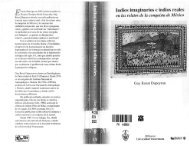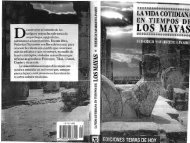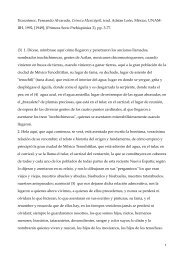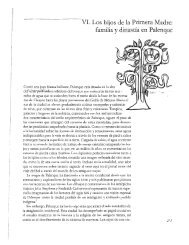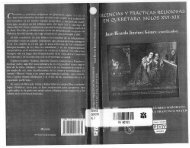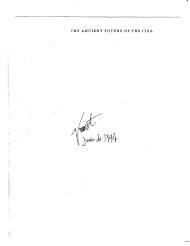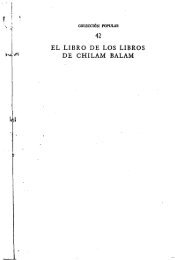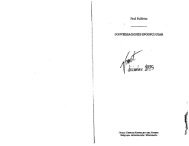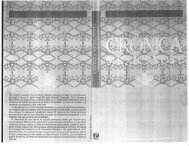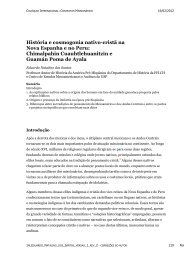HEAVEN BORN MERIDA AND ITS DESTINY - Histomesoamericana
HEAVEN BORN MERIDA AND ITS DESTINY - Histomesoamericana
HEAVEN BORN MERIDA AND ITS DESTINY - Histomesoamericana
Create successful ePaper yourself
Turn your PDF publications into a flip-book with our unique Google optimized e-Paper software.
20<br />
INTRODUCTION<br />
There is a strong polarization by rank and favor in these texts. Insults<br />
abound—since the text is Xiu, the Itza are often characterized as lying,<br />
stupid, stuttering orphans and insane fly-by-night (two-day and three-day]<br />
lords, drunken buzzards, monkeys and dogs, oversexed, lustful, and addicted<br />
to sodomy. The Itza of course reciprocate in kind. When they are<br />
really aroused, the Maya produce slang curses that sound almost like GI<br />
Joe: "This asshole boils war!" Correspondingly, the language of deference<br />
is considerably elaborated, and there are many standard honorifics: father,<br />
older brother, honorable, remote or holy, heaven born, glorious (sun face),<br />
great (seventh, ninth, thirteenth), or tremendous [chac).<br />
Even more poetic effects are found occasionally, as in the anaphoric repetition<br />
and climax of the following:<br />
There appeared the moon;<br />
The moon left.<br />
It returned,<br />
And the moon of the moon occurred, (lines 669-672)<br />
There is sometimes a deft use of chiasmus:<br />
Shaped by the juice of heaven:<br />
By dew of heaven shaped, (lines 1703-1704)<br />
Allegory is also to be found, as in the myth of the origin of the Xiu as a<br />
consequence of Hummingbird's sipping the nectar of the flowers, alluded<br />
to following line 3324.<br />
Although the entire text of the Chumayel is poetic, it appears to be specifically<br />
lyric in only a few passages: "The Song of the Itza" in chapter 42<br />
and the elegant introit to "The Count of the Katuns" in chapter 17. Sections<br />
of the myth "The Birth of the Uinal" in chapter 20 attain a similar<br />
lyricism. At least the first two of these fully qualify as poems.<br />
Drama. Drama is fundamental to our text. There is a great deal of preoccupation<br />
with ritual throughout the work—with the Christian sacraments<br />
(baptism, marriage, burial) and rites (absolution, benediction, kneeling,<br />
repentance, mourning, sermons, prayer, praise, anointing with oil,<br />
the sign of the cross) as well as Mayan ceremonials (of the uinal, the tzol<br />
kin, the tun, the hah, the katun, the may, the baktun) and ceremonies<br />
(sacrifice, divination, curing, examination, request, pacing and seating of<br />
land, commemoration). It is curious that there is no specific reference to<br />
the eucharist among the Christian rites or to confession, which is prominent<br />
in both Catholic and Mayan religions. Perhaps the emphasis on the<br />
rite of forgiveness is intended to refer to the latter.<br />
The ceremonials of the Maya are largely tied to the cycles of the calendar.<br />
The principal tzol kin ceremonies were those of the Burner [ah toe)<br />
cycle of the quarter tzol kin. These were held on certain occurrences of<br />
the days Chicchan, Oc, Men, and Ahau, and they survive as the tup' kak<br />
'quenching fire' ceremonies described by Villa Rojas (1945: 79, 116). In<br />
each quarter tzo7 kin there was a cycle of fire ceremonies; thus on 3 Chicchan<br />
the Burner "took his fire," on 10 Chicchan he lit it, on 4 Chicchan<br />
his fire "dawned," and on 11 Chicchan it was extinguished. The cycle was<br />
then rep<br />
than tha<br />
they are<br />
lation to<br />
Uinal<br />
scatterec<br />
were hel<br />
uinals oi<br />
Tun ct<br />
not desc:<br />
them, pa<br />
and ho h<br />
particule<br />
tion of ti....<br />
katun.<br />
All riti<br />
of the ka<br />
nificant <<br />
baktun]"'<br />
drama. A<br />
26, 28, 3;<br />
despite tJ<br />
incense, •<br />
the like i<br />
Fouroi<br />
tions of r<br />
12 and 4(<br />
of the ha<br />
ceremonj<br />
charactei<br />
stage dire<br />
by detail:<br />
times dir<br />
imperson<br />
1179-11Í<br />
Thech<br />
tated at 1<<br />
was a chc<br />
icalrepet<br />
reenacted<br />
The cei<br />
directly d<br />
the cererr<br />
of the eig<br />
these act!<br />
For reasoi<br />
8 to 20 ra<br />
Act 8. (



